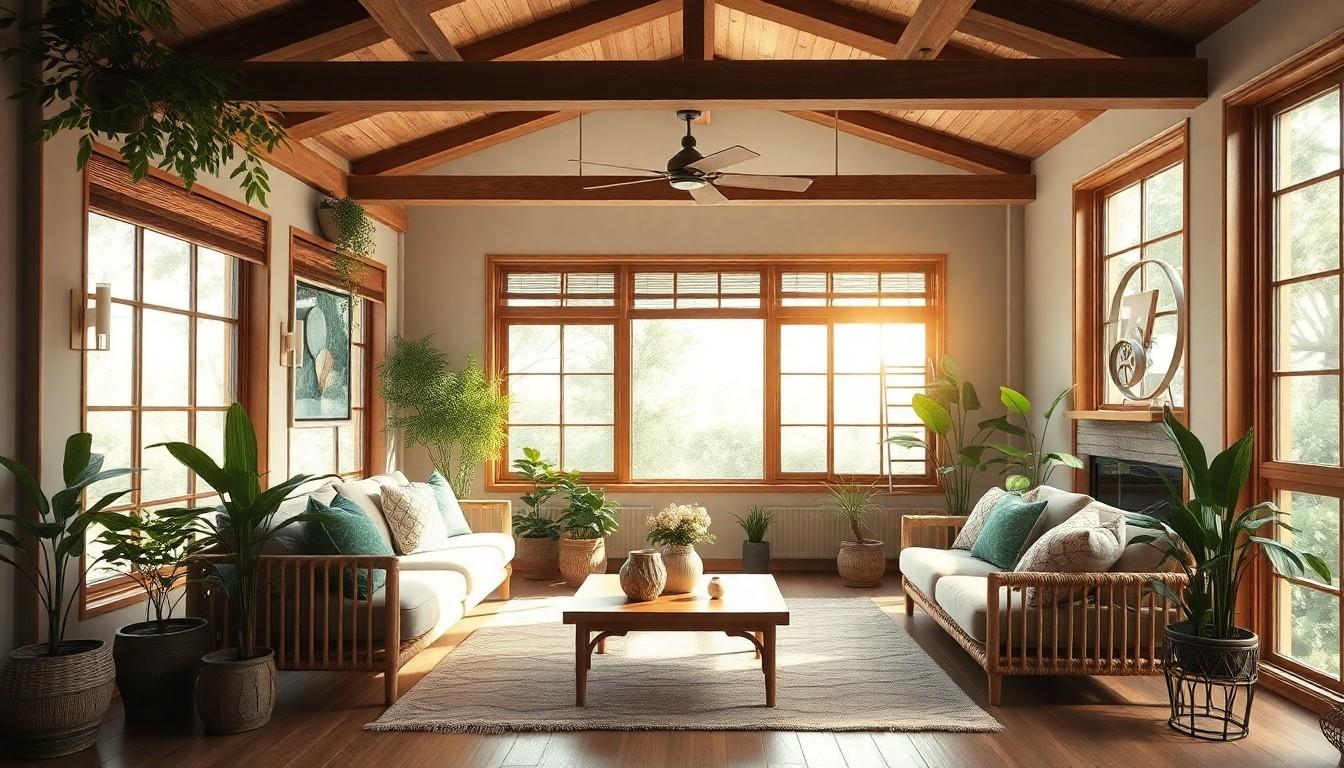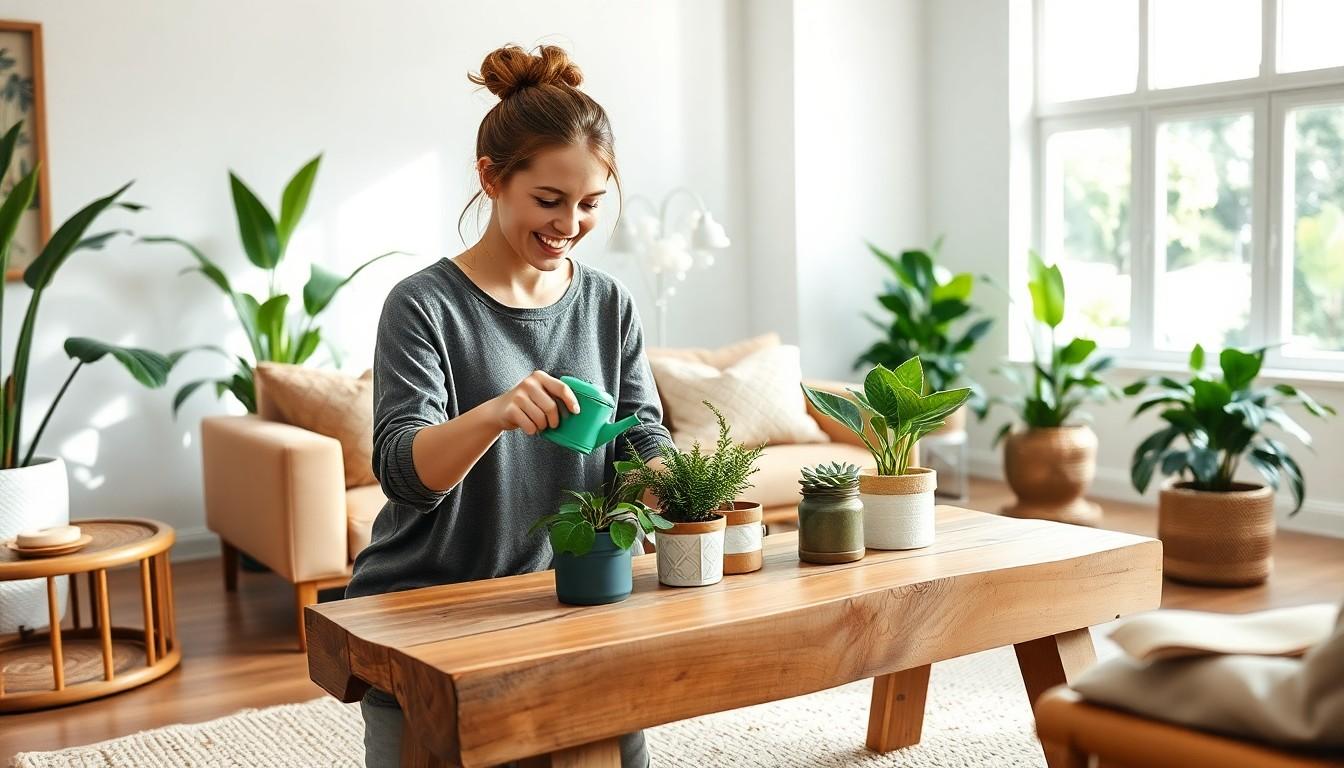In a world where the planet’s health hangs by a thread, why not give your living room a green makeover? Eco-friendly interior design isn’t just a trend; it’s a lifestyle choice that transforms spaces into havens of sustainability. Imagine lounging on a sofa made from recycled materials while sipping organic tea, all while Mother Nature gives you a thumbs-up.
Creating an eco-friendly living room doesn’t mean sacrificing style or comfort. In fact, it’s an opportunity to showcase creativity and innovation. From repurposed furniture to energy-efficient lighting, every choice can reflect a commitment to the environment. So, buckle up for a journey into the world of sustainable design that’ll have your friends green with envy—and not just from your plant collection! Get ready to turn your living space into an eco-chic sanctuary that’s as kind to the Earth as it is to your sense of style.
Living Room Eco Friendly Interior Design
Eco-friendly interior design centers on sustainability, emphasizing responsible material choices and energy efficiency. Sustainable practices reduce environmental impact while creating inviting spaces. Natural materials, such as bamboo, reclaimed wood, and organic textiles, enhance aesthetics and improve indoor air quality.
Designers often prioritize energy-efficient appliances and fixtures, which minimize energy consumption. LED lighting offers brightness while using less electricity, lowering utility bills and conserving resources. Additionally, eco-friendly paints and finishes emit fewer volatile organic compounds, promoting a healthier living environment.
Creating a harmonious living room involves thoughtful planning and intentionality. Incorporating plants not only décorates the space but also enhances air quality. Plants like snake plants and pothos thrive indoors and contribute to the natural ambiance.
Choosing furniture made from recycled materials can further promote sustainability. Many companies now offer stylish options crafted from reclaimed resources, blending modern aesthetics with eco-consciousness. Selecting multi-functional furniture maximizes utility while minimizing waste.
Color palettes often feature earth tones inspired by nature, fostering a calming atmosphere. Textures such as jute rugs and linen curtains add depth without compromising eco-friendly standards. Prioritizing simplicity and minimalism often leads to a more sustainable and visually appealing living space.
Overall, adopting eco-friendly interior design principles enables individuals to create beautiful living environments that reflect their values. Embracing this approach not only supports the planet but also enhances personal well-being.
Benefits Of Living Room Eco Friendly Interior Design

Living room eco-friendly interior design offers numerous advantages for both individuals and the environment. It enhances comfort and promotes a healthier lifestyle.
Improved Air Quality
Enhanced air quality stands as a significant benefit of eco-friendly design. Natural materials, such as bamboo and reclaimed wood, reduce indoor pollutants. Using low-VOC paints and finishes also minimizes harmful emissions. Indoor plants serve a crucial role, filtering air while adding greenery. Families experience better health as these elements create a more pleasant living environment. Individuals notice fewer allergens, which can lead to improved respiratory health. Clean air supports overall well-being and boosts mood. Incorporating sustainable practices fosters a refreshing and lively atmosphere.
Energy Efficiency
Energy efficiency profoundly impacts household costs and the environment. Choosing energy-efficient appliances and LED lighting conserves electricity. Better insulation reduces heating and cooling demands, leading to lower utility bills. When households utilize sunlight through strategically placed windows, they decrease reliance on artificial lighting. Opting for multi-functional furniture helps maximize spaces without excess energy use. Sustainable materials often feature energy-saving attributes that benefit both design and operation. Such considerations allow owners to enjoy stylish décor while making responsible choices. Prioritizing energy efficiency enhances a home’s comfort and reduces its carbon footprint.
Key Elements Of Eco Friendly Living Room Design
Creating an eco-friendly living room incorporates various critical elements that enhance sustainability and aesthetics. Focus on furniture and materials that promote both style and environmental responsibility.
Sustainable Furniture Options
Choose furniture crafted from reclaimed or sustainably sourced wood. This option not only minimizes waste but also adds character to the living room. Consider selecting pieces made from recycled materials such as metal or plastic, which reduce the demand for new resources. Opt for vintage or second-hand items; these choices offer unique designs while keeping furniture out of landfills. Prioritize brands that practice ethical manufacturing processes to support responsible production. Finally, embracing multi-functional furniture, like sofa beds or modular storage, maximizes utility in smaller spaces, embodying eco-friendly principles.
Eco Friendly Materials and Textiles
Utilize natural materials such as organic cotton, linen, or hemp for upholstery and curtains. These fabrics contribute to better indoor air quality and lessen chemical exposure. Incorporate sustainable flooring options, including bamboo or cork, which are renewable and durable. In addition, wool and jute rugs add texture while being biodegradable. Avoid synthetic fabrics that release harmful pollutants; seek out textiles labeled as low-VOC to ensure a healthier atmosphere. Lastly, explore eco-conscious paint options that contain fewer volatile organic compounds, enhancing both aesthetics and wellness within the living room.
Creating a Biophilic Design
Biophilic design incorporates nature into living spaces, enhancing wellness and aesthetics. This approach promotes a harmonious connection between indoor environments and the natural world.
Incorporating Plants
Adding plants significantly improves indoor air quality. Plants like snake plants and pothos efficiently filter toxins, creating a healthier atmosphere. They also infuse color and texture into the space. Positioning greenery throughout the living room adds visual interest and promotes relaxation. Consider utilizing vertical gardens or plant shelves to maximize space. Select low-maintenance species for easy care, encouraging a vibrant, lively environment. Integrating plants symbolizes a commitment to sustainability and enhances overall well-being.
Natural Light Utilization
Natural light plays a crucial role in biophilic design. It energizes a space and contributes to mood elevation. Maximizing sunlight via large windows or strategically placed mirrors brightens the living room, reducing the need for artificial lighting. Choosing sheer drapes allows light to filter in while maintaining privacy. Skylights offer an innovative way to bring in even more daylight. Implementing light colors on walls and furniture reflects light, adding to the room’s brightness. Emphasizing natural light fosters a vibrant, welcoming atmosphere that complements eco-friendly design principles.
Tips for Implementing Eco Friendly Practices
Implementing eco-friendly practices enhances living spaces while ensuring sustainability. Several strategies can transform a traditional living room into a green sanctuary.
Upcycling and Recycling Decor
Upcycling furniture offers a creative approach to design. Furniture pieces can be refurbished with new finishes or reupholstered, reducing waste and resource use. Homeowners can also source vintage items at thrift stores, giving them a second life. Recycling materials, such as glass and metal, contributes to a stylish aesthetic while supporting sustainability. Unique decor elements made from recycled resources add character and charm. Using repurposed materials for shelving or art displays fosters a more environmentally conscious environment. It’s possible to achieve a distinctive look and support eco-friendly practices simultaneously.
Choosing Non-Toxic Paint and Finishes
Selecting non-toxic paints and finishes promotes healthier indoor air quality. Low-VOC paints emit fewer harmful chemicals, contributing to a safer living space. Many brands now offer eco-friendly alternatives without sacrificing color vibrancy. Applying natural oils and wax finishes not only protects surfaces but also aligns with environmental goals. Surfaces finished this way resist wear while improving the overall aesthetic. DIY projects should incorporate these products to enhance the sustainability of any decor. Prioritizing these options makes any design choice a step towards a greener future.
Embracing eco-friendly interior design in the living room not only enhances aesthetics but also fosters a healthier environment. By making mindful choices in materials and furnishings, individuals can create spaces that reflect their values while supporting sustainability. Incorporating elements like plants and natural light further elevates the ambiance, promoting well-being and relaxation.
Adopting these principles transforms living areas into inviting sanctuaries that impress guests and contribute positively to the planet. As homeowners choose eco-conscious options, they pave the way for a greener future, proving that style and sustainability can coexist beautifully.

